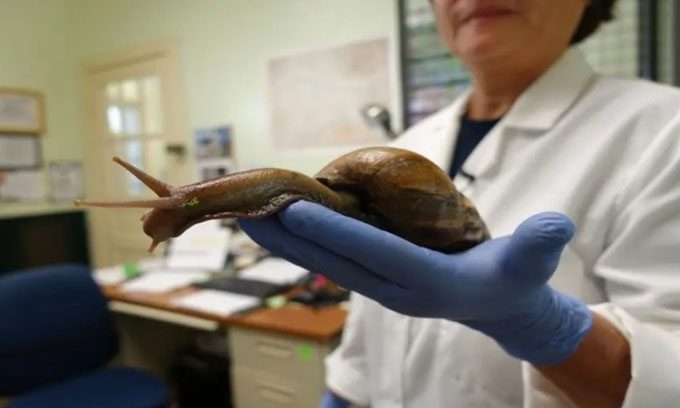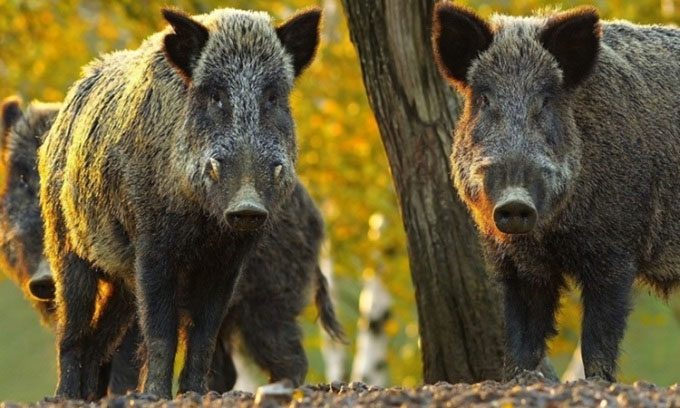Many invasive species in the United States pose a threat to native flora and fauna, damage infrastructure, harm agriculture, and transmit diseases to humans.
Nutria

Nutria are relatively large rodents. (Photo: Guardian).
The nutria is a large aquatic rodent that resembles a cross between a beaver and an oversized rat. Similar to beavers, they have orange-colored teeth due to a special enamel that contains iron. This stout, neckless rodent can grow up to 60 cm long and weigh 9 kg. Native to South America, nutria were introduced to the United States in the late 1890s due to the fur trade. According to the U.S. Department of Agriculture (USDA), many escaped or were released into the wild in the 1940s. Today, this invasive species has spread to at least 20 states, primarily in the Gulf Coast region, including Louisiana and Florida.
Nutria destroy environments partly due to their voracious appetites. They consume an amount of vegetation equal to 25% of their body weight each day and forage by burrowing, which damages soil, devastates native vegetation, causes erosion, and destroys infrastructure.
Giant African Land Snail

The Giant African land snail poses a threat to infrastructure. (Photo: AFP).
The Giant African land snail can grow up to 20 cm long. This native of East Africa is considered one of the most damaging snail species in the world. They were introduced to Hawaii in 1936 and to the mainland U.S. in 1966, according to the USDA. When the snails were discovered in Florida in the 1960s, a $1 million eradication effort lasted for 10 years. However, authorities recently detected the Giant African land snail in Florida once again.
These snails feed on at least 500 different plant species and can damage structures made of mortar and plaster. Not only do they lay 1,200 eggs each year, but they also carry parasites that can cause meningitis in humans.
Hammerhead Worms
Hammerhead worms, native to Southeast Asia, can reach lengths of 30 cm with long, flat bodies. They also have a flat head resembling that of a hammerhead shark. This species was first recorded in the U.S. in 1891 and has been found in states such as Texas, Arkansas, and Georgia. They are effective predators, specializing in eating earthworms, which play a crucial role in maintaining soil health.
“If earthworms are wiped out, plants will not have the necessary nutrients. This can affect the growth of crops and garden plants,” said Ashley Morgan-Olvera, a researcher at the Texas Invasive Species Institute.
Asian Longhorned Ticks
The Asian longhorned tick is the size of a sesame seed and is native to eastern China, Japan, Russia, and Korea. These light brown ticks have been present in the U.S. since at least 2010 and have spread to several eastern states, according to the USDA.
This invasive species poses a threat to native animals and can infect sheep, goats, dogs, cats, horses, deer, and humans. They can even kill livestock. In 2021, a farmer in Ohio discovered three dead cows covered in Asian longhorned ticks. These ticks can reproduce asexually, meaning one tick can create a new population by laying 2,000 eggs.
Wild Hogs and Super Hogs

Super hogs from Canada are crossing the northern border into the U.S. (Photo: CTV).
Hogs, native to Europe and Asia, were brought to the U.S. in the 16th century by early explorers as a food source. The wild hogs in the U.S. today belong to the same species as farmed pigs. They inhabit the southern U.S. and California. However, super hogs from Canada may be invading the U.S. from the north. These super hogs are hybrids of domestic pigs and European wild boars, bred decades ago to produce larger pigs. Super hogs have thick fur that helps them survive the cold winters in Canada and northern U.S.
These pigs can weigh over 272 kg and hunt native species such as frogs, salamanders, and ground-nesting birds. They also destroy crops by rooting through the ground for plant roots and insect larvae. Super hogs have been reported in North Dakota and South Dakota, but they have not yet established permanent populations.


















































